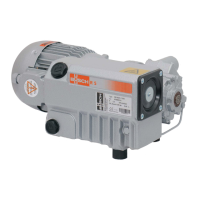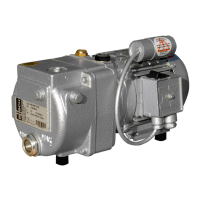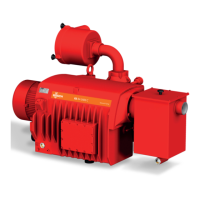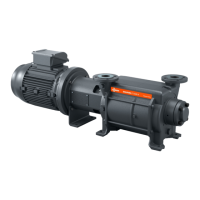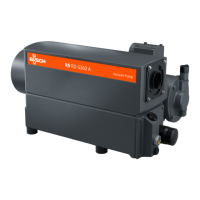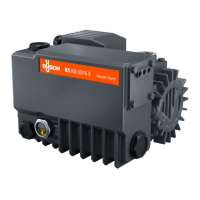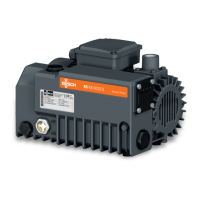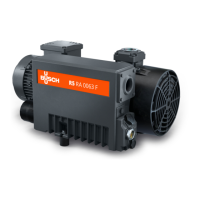4
Non-detergent oil should be used. Do not use
detergent motor oil as additives in detergent oil will
plug exhaust filter elements and shorten their life.
It is recommended that Busch R500 Series oil be used
to receive the best performance from your vacuum
equipment. R500 Series oil is a high quality vacuum oil
that will give longer running time between oil changes,
will provide better lubrication at high operating temper-
atures, and will prolong the life of exhaust filter ele-
ments. This oil can be obtained directly from Busch,
Inc. in Virginia Beach, Virginia.
The strict use of Busch oils and parts from the day of
purchase can extend the Limited Standard Warranty to
three years. Contact Busch, Inc. in Virginia Beach,
Virginia for details.
For general applications, use R530 in all models cov-
ered by this manual. Use R590 or R570 in pumps that
are operated in high ambient temperatures (above
90°F) or when the oil carbonizes (turns black) before
the change interval. Use R590 or R570 on 0250
pumps. Contact the factory for recommendations when
using other oils.
The TECHNICAL DATA chart on page 14 gives the
approximate quantities of oil required for each pump.
The oil capacity chart should only be used as a guide,
since oil capacity may be slightly lower, depending on
whether the pump was filled previously, and whether all
components such as oil filter, oil lines, etc., were
allowed to completely drain. Use only the sight glass
reading for proper level. Never overfill!
For ambient operating temperatures lower than 41°F,
use Busch R580 synthetic oil. If this does not help
(where the pump has difficulty starting due to high oil
viscosity), contact the factory in Virginia Beach,
Virginia.
Replace the oil fill plug (Ref. 88), making sure that the
gasket (Ref. 89) is in place and properly seated and
secured. Some pumps are equipped with an exhaust
pressure gauge as an integral part of the oil fill plug.
Switch the power back into the "on" position.
2.0 OPERATION
2.1 Start-up
Check rotation of the motor as described in Section 1.3
- Power Requirements.
Fill the pump with oil as described in Section 1.5 - Oil
Filling.
Start the pump and immediately close the inlet. Run the
pump for a few minutes before checking the oil level
again. With the pump shut off, the oil level should be
visible in the oil sight glass (Ref. 83), between the "MIN"
and "MAX" mark.
Add oil, if necessary, but only add it when the pump has
been shut off and the circulating oil has had sufficient
time to return to the oil sump.
Note: The oil separated by the exhaust filter element
forms droplets on the outside of the exhaust filter that
collect at a low point in the upper half of the exhaust
box. From there the collected oil is drained back to the
oil sump via an oil check valve (Ref. 275) which opens
on R 5 RA model pumps when the pump is shut off. It
is necessary to shut off the RA model pumps after every
8 hours of operation to allow the check valve to open.
If the pump is not shut off after this time period, it is pos-
sible to starve the pump of oil since the oil is not allowed
to drain back into the oil sump and/or oil droplets may
be blown out of the exhaust. If the pump is operating at
high pressure it may be necessary to shut it down soon-
er than 8 hours.
On R 5 (Standard) RC model pumps, the collected oil is
drawn continuously during operation of the vacuum
pump to the inlet flange (Ref. 260) via the oil return line
(Ref. 290). The oil return line is connected directly to
the area of the exhaust box, downstream of the exhaust
filter, which is at atmospheric pressure. Therefore, a
constant amount of air is sucked into the pump, which
is an additional reason that the R 5 Standard Series
Pumps do not achieve as low a vacuum as the R 5
Series Super Vacuum Pumps. RC model pumps can
run continuously without having to shut them off for the
oil to drain back.
2.2 Gas Ballast
All RA Series pumps are equipped with a gas ballast
valve. The gas ballast valve (Ref. 440) is located
between the inlet port and the exhaust box. RA series
pumps are equipped with a permanent gas ballast
which cannot be shut off unless the sintered filter is
removed and the orifice plugged. Larger pumps are
equipped with an adjustable gas ballast valve.
The adjustable gas ballast valve should normally be left
open. Its primary function is to prevent water vapor
from condensing in the pump. Condensation causes
emulsification of the oil, loss of lubricity, and possible
rotor seizure.
WARNING: Keep the oil fill plug tight as
pressure in the exhaust box could cause
bodily injury if the plug is blown out. Do not
fill/add the pump with oil through the
exhaust/inlet ports as there is danger of
breaking the vanes!

